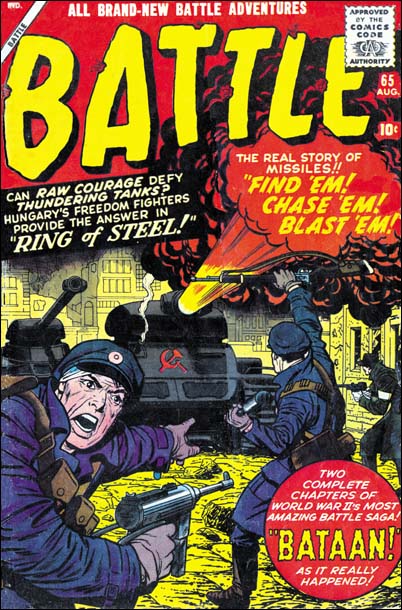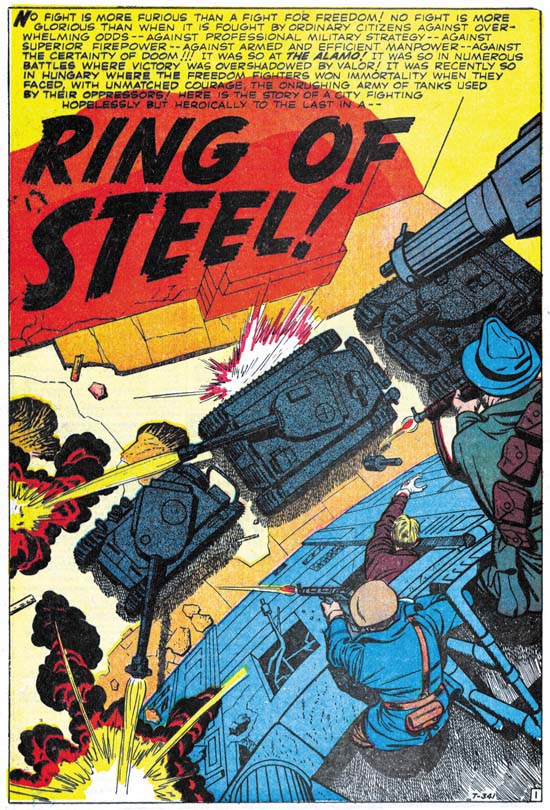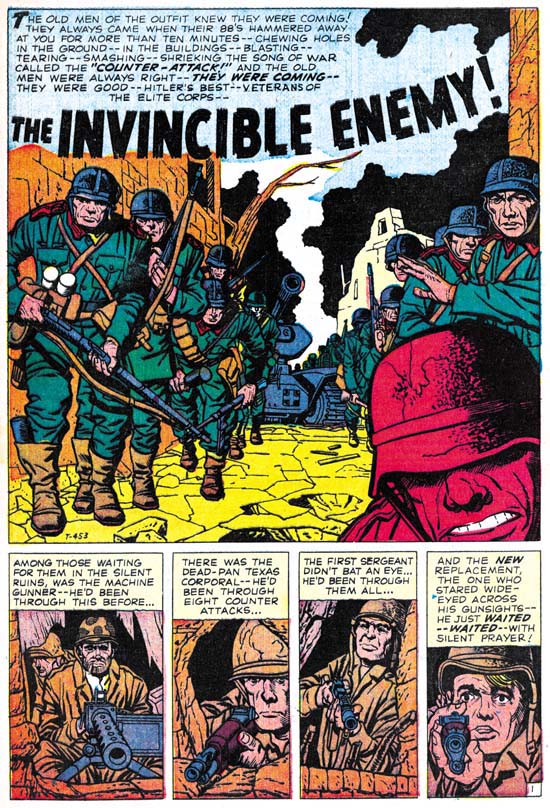Recently I posted in some details on Foxhole, Simon and Kirby’s own war comic book. I thought it might be fun to examine some of the work in this genre that Kirby did later in his career. In this post I will look at a couple of stories from Battle, an Atlas title.
Kirby’s work for Atlas as a freelancer was interrupted by the Implosion. Thomas G. Lammers has a marvelous paper called “Tales of the Implosion”. I use the self published version (if you are interested in getting your own copy email Tom at tlammers@new.rr.com). Tom points out that some of the work after the Implosion was from a sort of inventory. He indicates that for Battle new work started to appear with issue #62 (February 1959). By the time Kirby work appears in Battle #67 (December) the comic is produced entirely from new material. The job numbers allow us to distinguish newly produced work from pre-Implosion inventory. All the Kirby battle stories have job numbers starting with T which allows us to say that they are all post-Implosion creations.

Battle #65 (August 1959) cover by Jack Kirby
Although Kirby may not have had as much control over his work for Atlas after the Implosion, at least he started to produce covers. The covers that Jack did for Atlas/Marvel varied greatly in quality. Some of that variation is of course due to Jack himself. However for me most of it is due to the various inkers used. Some were more sensitive to Kirby’s pencils, others tended to overwhelm them. Cover layouts for Jack’s Atlas/Marvel period are generally quite different then produced under the Simon and Kirby collaboration. The questions is was this new look really Kirby’s or could it have been due to his working from someone else’s layouts?
I am not going to try to provide a blanket answer. Jack would do a lot of covers for Atlas/Marvel and I suspect the answer to who was responsible for the layouts may have varied. Instead I will focus on the covers Jack did for Battle and use issue #65 as an example. Note the fighter on our left and how he seems to be looking out of the page calling for reinforcements. This is a device that Jack used earlier in his career when depicting combat. Now at the time the combat included superheroes or kid gangs but the general concept was the same. An example of this compositional technique is Champ #23 (October 1942). This is an effective device as it acts to place the viewer as part of the action. Sometimes this can be a bit paradoxical as Jack would sometimes portray a foe as the caller which would place the viewer as one of the enemies. This device was later abandoned by Simon and Kirby. Now part of this can be explained as due to WWII being over. But when S&K produced Foxhole Jack penciled all the covers and he never returned to using the calling figure.
Not only does Battle #65 use this calling soldier device, but it also shows up on issues #66 and #67. When we look at earlier Battle covers although we find soldiers looking out toward the viewer none of them are calling out. Therefore I would suggests that this figure was Kirby’s. On all the Battle covers that use this calling figure it plays an important part of the total composition. I consider it a good indication that Kirby is responsible for these layouts.
It is interesting to observe that once more Jack has turned to using a technique from early in his career. We previously observed circular panels and figures extending past panel borders. Those two techniques resurfaced in Challengers of the Unknown, The Yellow Claw and the Black Rider Rides Again. However in those cases the technique would be dropped after a short period of use, perhaps because the publishers felt it was too old fashion. This fate did not happen to the calling figure device. Jack would not use it frequently but he would occasionally use it throughout his career. The goofy Captain America #197 (May 1976) is a good example.

Battle #65 (August 1959) “Ring of Steel” art by Jack Kirby
1959 found the U.S. in the grips of the Cold War. The Hungarian Revolt had occurred less then three years before. “Ring of Steel” does not include the start of the rebellion, when a student protest escalated to the point that the Communist government in Hungary was deposed and the Russians expelled. Instead the comic story begins with the reports of Russian tanks grouping outside the city. When the Russians enter the city the citizens fight desperately to keep their freedom. Of course in the end they are defeated by the overwhelming force sent against them.
I was rather young when the Hungarian Revolt toke place. and was raised during the height of the Cold War. My father’s side of my family was Polish with relatives still living under the Communist regime. With my background it is not at all surprising how moving I find “Ring of Steel”. Still even an inspiring story needs a good writer to be truly effective. I feel the author of “Ring of Steel” did an excellent job. For example page four has three rows of panels with two or three panels per row. Each row starts with how the patriots would fight the Russians. Each row would then end with the unfortunate results of those attempts. The same caption is used on the last panel of all the rows, “… against hopeless odds”. Very good scripting. I wish I could credit Jack Kirby with this writing. Frankly it just does not read like his work to me. Particularly things like page four sound more like something from a writer then a visual artist.
A good comic book story needs more then just good writing. It requires great art as well. Of course with Jack Kirby as the artist, the great art in the story is not much of a surprise. I do not know the inker, Silver Age inkers are not an area that I am knowledgeable about. I can say that Jack did not ink this job himself. Whoever the inker was he did a good job. He did not attempt to “correct” Kirby’s pencil nor did he overpower them.
I want to take particular note about the splash page whose image I provide above. Jack was famous for his use of exaggerated perspectives. Still there is something unusual about this splash. In “The Comic Book Makers” Joe Simon describes the proper way to create art for 3D comics. Joe’s prescription is that the art should project out to the user, not into the page. Well Jack generally followed that rule not just for 3D art but whenever he used his special perspective. Early in his career Kirby did not follow that procedure, he developed it as he gained experience. For this splash he completely disregards this canon, but with good reason. The perspective directs us from the freedom fighters with their small arms down to the object of their assault, the massive power of the Russian tanks. In doing so Jack not only condenses all the action into a tightly knitted scene, but also makes the viewer feel as if he is participating in the fight. Kirby’s cover on the same theme (see image above), wonderful though it is, pales by comparison to the splash. What a masterpiece.

Battle #67 (December 1959) “The Invincible Enemy” art by Jack Kirby
The main character of “The Invincible Enemy” is a new replacement, but some other battle hardened soldiers play secondary roles. They are part of a force trying to hold a town from some elite German forces. The replacement is clearly frightened and when the German counter attack begins he initially freezes up. Prompted by his sergeant he then joins the fray but it is the more experienced fighters that take the lead. One by one these fighters succumb to the Nazi onslaught. The replacement is suddenly filled with fury and becomes a one man assault team. He not only overcomes the German soldiers that attach him, but also takes out a tank. By the time his fury is extinguished, the fight is over and the German counter attach has failed.
This story reminded me a lot of “The Replacement” from Foxhole #2 (December 1954) drawn by Bill Draut. Both concerned an inexperienced replacement and an intense German attack. There are important differences between the two. The replacement is really the only character for the Foxhole story. We are shown some of the “veterans” but none of them stand out or take any significant part of the story. While in the Battle story there are three other soldiers that are unidentified and play a part in the tale. Draut’s replacement fights heroically but you never get the impression that he is any different from the other soldiers in his unit. With Kirby the rest of the unit is defeated while the replacement becomes a sort of super-soldier. In some ways “The Invincible Enemy” is “The Replacement” on steroids. Having said all this, for me it really is not a case of one story being better then the other. Each has their own theme and flavor and I think both are superb works of comic book art. Jack Kirby was a better artist, but Bill Draut’s efforts should not be dismissed.
Jack has once more supplied excellent art. Again Kirby is not inking his own work. After the Atlas Implosion and outside of the late Prize romances, Kirby inking Kirby would be very rare occurrences. Here the inker does a great job and does not overwhelm Jack’s pencils.
You can tell that Kirby and the writer are making great efforts to provide high impact while skirting the Comic Code. The best example of this it the fate of the machine gunner. At the start of the fight we see a German soldier throw a grenade. In the next panel The caption accompanying the violent explosion says that the machine gunner was driven back to another position. But in the following panel we see the German soldiers storming into opening. At their feet on one side are the upturned legs of the machine gun while on the other side a pair of boots are visible and they show that the gunner is face down. Clearly indicating the machine gunners new position actual is. Despite the fierce fighting this is the only death depicted.
Jack did other work for the Battle. The two stories that I discuss here are my favorite, but by no means do I denigrate his other work for this title. All of them are great examples of what Kirby could do. As for the other artists whose creations appear in Battle, well they really are outside of the focus of this blog since they never worked for Simon and Kirby. Still there is some worth while stories here besides those by Kirby. Marvel has been reprinting some of their older material. This effort has largely been focus on their superheroes. But a few volume of their “monster” and western comics have been reprinted. Perhaps, just maybe, someday Battle might be reprinted. I think it would be worth it. Hey a fellow can dream can’t he?


I love the perspective as well on the splash page of Ring of Steel. I still feel that Kirby had a hand in the writing of these stories, even if they were edited by Stan Lee, which is quite likely.
The inker for these 2 stories is Christopher Rule, and I agree he did a fine job over Kirby.
Nick Caputo
Nick,
Although I will not make the claim for all Battle stories that Kirby drew, in the case of “Ring of Steel” I really think the writing was not Jack’s. Not at all like his use of words. And I do not think I have ever read anything by Jack where he used the type of repitition as occurs on page 4. I leave open questions of possible involvement in plotting.
Thanks for your observation about the inking being by Christopher Rule.
Harry
Hi,
In an unpublished article I did for TJKC about two years ago, I wrote about Jack’s 1955/6 work at Timely. The article was called When Jacob Met Stanley. I am glad to see you are covering this period as well.
Have you had a look at the two earliest ‘sf’ stories he did yet? Form the job numbers I get the impression they could have been brought in by Jack as left over stuff from the temporary stop in publication of the Harvey horror books. It wouldn’t even surprise me if there is some Joe Simon inking in them, but you are a better judge of that than I am.
This is the explenation of the job numbers. It is most likely that job numbers wre given out to written stories rather than drawn ones. They were added to a script when it was brought in by the writer (at which point they were also entered for payment, so that makes sense. We know this because some treatments have turned up without a job number and Doc files’ of one of those writers confirms this.
If you look at the first three job numbers Jack Kirby did, this could mean he brought in the stories already done. Stan bought them and added kob numbers. He also gave Jack a new (war) story to draw, which had a job number earlier than the stories Jack brought in, because it was picked from the pile of scripts.
K-282 Battleground #14 (Nov/56) “Mine Field!” 5 pages
K-651 Str. Tales o.t. Unusual #7 (Dec/56) “Poker Face!” 4 pages
K-652 Astonishing #56 (Dec/56) “Afraid to Dream!” 4 pages
I’d love to hear your take on this. If you haven’t got scans of those stories I can provide them. Contact me privately.
Ger,
Unfortunately I have not seen all the pre-Implosion Kirby stuff. But I have seen and posted on Astonishing #56 (//kirbymuseum.org/blogs/simonandkirby/archives/705). My conclusion was that it was written, drawn and inked by Jack although it was not his best inking. I will be returning to the inking question in a serial post on Kirby’s “late” inking style that I will be starting in a week or so.
Originally I surmised that in all his pre-Implosion work Kirby had similar control over his material. But Jack’s Black Rider work convinces me otherwise. As for your theory that Jack brought the work in finished that is certainly a possibility (at least for Ast. #56). But I will say that Harvey was publishing Kirby material at this time so I see no reason why it should be left over from that publisher.
Harry
Harry,
In the Strange Tales Of The Unusual story I detect a few Simon touches, so I’ll try and get it out, scan it and let you take a look at it. As I showed above, if Astonishing was brought in, the job numbers show that Unusual was brought in with it. I mentioned Harvey because I thought the Harvey ‘horror’ books were suspended for a year around that time. We are talking about a publishing date of late 1956. Black Cat was suspended for a year between #58 and #59. At the time it may have seemd the book was cancelled and Jack could have taken the two stories to Stan. The timing seems to fit.
Ger,
The Strange Tales and Astonishing Kirby stories were cover dated for December 1956. Harvey published Black Cat Mystery #57 in January 1956 while Black Cat Mystic #58 was September 1956. So your theory could be correct as far as that is concerned.
Harry